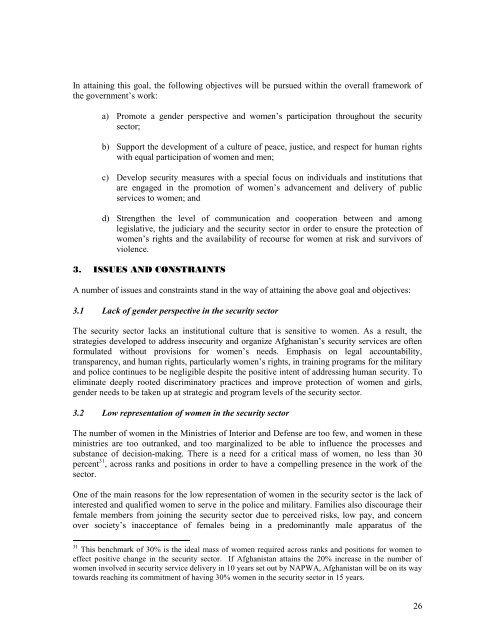National Action Plan for the Women of Afghanistan - The Secretary ...
National Action Plan for the Women of Afghanistan - The Secretary ...
National Action Plan for the Women of Afghanistan - The Secretary ...
- No tags were found...
You also want an ePaper? Increase the reach of your titles
YUMPU automatically turns print PDFs into web optimized ePapers that Google loves.
In attaining this goal, <strong>the</strong> following objectives will be pursued within <strong>the</strong> overall framework <strong>of</strong><br />
<strong>the</strong> government‘s work:<br />
a) Promote a gender perspective and women‘s participation throughout <strong>the</strong> security<br />
sector;<br />
b) Support <strong>the</strong> development <strong>of</strong> a culture <strong>of</strong> peace, justice, and respect <strong>for</strong> human rights<br />
with equal participation <strong>of</strong> women and men;<br />
c) Develop security measures with a special focus on individuals and institutions that<br />
are engaged in <strong>the</strong> promotion <strong>of</strong> women‘s advancement and delivery <strong>of</strong> public<br />
services to women; and<br />
d) Streng<strong>the</strong>n <strong>the</strong> level <strong>of</strong> communication and cooperation between and among<br />
legislative, <strong>the</strong> judiciary and <strong>the</strong> security sector in order to ensure <strong>the</strong> protection <strong>of</strong><br />
women‘s rights and <strong>the</strong> availability <strong>of</strong> recourse <strong>for</strong> women at risk and survivors <strong>of</strong><br />
violence.<br />
3. ISSUES AND CONSTRAINTS<br />
A number <strong>of</strong> issues and constraints stand in <strong>the</strong> way <strong>of</strong> attaining <strong>the</strong> above goal and objectives:<br />
3.1 Lack <strong>of</strong> gender perspective in <strong>the</strong> security sector<br />
<strong>The</strong> security sector lacks an institutional culture that is sensitive to women. As a result, <strong>the</strong><br />
strategies developed to address insecurity and organize <strong>Afghanistan</strong>‘s security services are <strong>of</strong>ten<br />
<strong>for</strong>mulated without provisions <strong>for</strong> women‘s needs. Emphasis on legal accountability,<br />
transparency, and human rights, particularly women‘s rights, in training programs <strong>for</strong> <strong>the</strong> military<br />
and police continues to be negligible despite <strong>the</strong> positive intent <strong>of</strong> addressing human security. To<br />
eliminate deeply rooted discriminatory practices and improve protection <strong>of</strong> women and girls,<br />
gender needs to be taken up at strategic and program levels <strong>of</strong> <strong>the</strong> security sector.<br />
3.2 Low representation <strong>of</strong> women in <strong>the</strong> security sector<br />
<strong>The</strong> number <strong>of</strong> women in <strong>the</strong> Ministries <strong>of</strong> Interior and Defense are too few, and women in <strong>the</strong>se<br />
ministries are too outranked, and too marginalized to be able to influence <strong>the</strong> processes and<br />
substance <strong>of</strong> decision-making. <strong>The</strong>re is a need <strong>for</strong> a critical mass <strong>of</strong> women, no less than 30<br />
percent 31 , across ranks and positions in order to have a compelling presence in <strong>the</strong> work <strong>of</strong> <strong>the</strong><br />
sector.<br />
One <strong>of</strong> <strong>the</strong> main reasons <strong>for</strong> <strong>the</strong> low representation <strong>of</strong> women in <strong>the</strong> security sector is <strong>the</strong> lack <strong>of</strong><br />
interested and qualified women to serve in <strong>the</strong> police and military. Families also discourage <strong>the</strong>ir<br />
female members from joining <strong>the</strong> security sector due to perceived risks, low pay, and concern<br />
over society‘s inacceptance <strong>of</strong> females being in a predominantly male apparatus <strong>of</strong> <strong>the</strong><br />
31 This benchmark <strong>of</strong> 30% is <strong>the</strong> ideal mass <strong>of</strong> women required across ranks and positions <strong>for</strong> women to<br />
effect positive change in <strong>the</strong> security sector. If <strong>Afghanistan</strong> attains <strong>the</strong> 20% increase in <strong>the</strong> number <strong>of</strong><br />
women involved in security service delivery in 10 years set out by NAPWA, <strong>Afghanistan</strong> will be on its way<br />
towards reaching its commitment <strong>of</strong> having 30% women in <strong>the</strong> security sector in 15 years.<br />
26
















